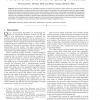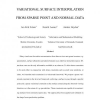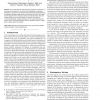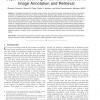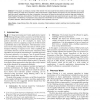143
Voted
PAMI
2007
15 years 15 days ago
2007
In this paper we present a two-level generative model for representing the images and surface depth maps of drapery and clothes. The upper level consists of a number of folds whic...
98
Voted
PAMI
2007
15 years 15 days ago
2007
—We present a novel convex programming scheme to solve matching problems, focusing on the challenging problem of matching in a large search range and with cluttered background. M...
112
click to vote
PAMI
2007
15 years 15 days ago
2007
—We document methods for the quantitative evaluation of systems that produce a scalar summary of a biometric sample’s quality. We are motivated by a need to test claims that qu...
128
Voted
PAMI
2007
15 years 15 days ago
2007
Many visual cues for surface reconstruction from known views are sparse in nature, e.g. specularities, surface silhouettes and salient features in an otherwise textureless region....
105
click to vote
PAMI
2007
15 years 15 days ago
2007
—The potential of brain electrical activity generated as a response to a visual stimulus is examined in the context of the identification of individuals. Specifically, a framewor...
PAMI
2007
15 years 15 days ago
2007
This paper introduces a novel approach for solving the problem of camera calibration from spheres. By exploiting the relationship between the dual images of spheres and the dual i...
119
Voted
PAMI
2007
15 years 15 days ago
2007
—A probabilistic formulation for semantic image annotation and retrieval is proposed. Annotation and retrieval are posed as classification problems where each class is defined as...
120
Voted
PAMI
2007
15 years 15 days ago
2007
—Fingerprint friction ridge details are generally described in a hierarchical order at three different levels, namely, Level 1 (pattern), Level 2 (minutia points), and Level 3 (p...
122
click to vote
PAMI
2007
15 years 15 days ago
2007
Abstract—We experimentally evaluate bagging and seven other randomizationbased approaches to creating an ensemble of decision tree classifiers. Statistical tests were performed o...
PAMI
2007
15 years 15 days ago
2007
—In this paper, we introduce a family of filter kernels—the Gray-Code Kernels (GCK) and demonstrate their use in image analysis. Filtering an image with a sequence of Gray-Code...

